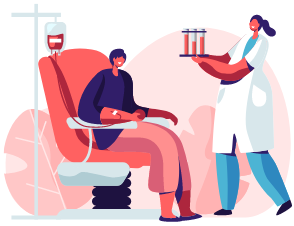Implementing human-centred design to achieve better long-term
patient outcomes
Putting Patients and Whānau at the Heart of Healthcare

David Price
Director of Patient Experience & Acting Associate General Manager, Waitakere Hospital
Waitematā District Health Board
Enhancing the patient experience
Medical clinics, hospitals and healthcare centres, by their very nature, are designed to treat and take care of patients. Yet sometimes the clinicians, physicians and directors of those centres are so busy doing their job and churning through their workload, that they neglect their primary focus. David Price , the Director of Patient Experience & Acting Associate General Manager at Waitakere Hospital and the Waitematā District Health Board, says that often “we need to think outside the square when it comes to how we put our patients at the heart of healthcare,” especially when it comes to designing or re-designing “our services or the healthcare delivery that we make.”
Many health professionals only think of the patient experience as what happens by the bedside or in the clinic. But the Beryl Institute, a US-based global community for healthcare professionals, defines the patient experience as “
the sum of
all interactions
shaped, by an
organisation’s culture
, that influences
patient perceptions
across the
continuum of care
.” David Price says that this a definition that many health professionals would do well to live by, and should take note of specific words within it:
- All interactions – “This includes interactions before the patient even gets to the health service. It might be a phone call with the organisation or a letter or email. It may also be the interaction with the car park sign that determines whether they enter or leave the car park depending on the prices. Then once they do enter, the next interaction may be at the front door. Are they welcomed, are people friendly when they walk in, especially if they look lost or confused, or do staff walk past them looking very busy and being unhelpful?”
- Organisation’s culture – “All of these interactions, even before a patient has dealt with a healthcare professional, shape the organisation’s culture.”
- Patient perception – “A welcome and friendly organisation will determine what the patient perceives as they progress through the consumer care that they have.”
- Continuum of care – “This is about where we refer our patients to, and many patients don’t see the difference between hospitals and providers. We need to be conscious of where we refer them to and why.”
All of these factors together will “improve, enhance or support our patients more effectively.” The one element that is missing though is “the impact or the involvement of the Whānau (extended family) that patients need.” The value of family and familial support services cannot be underestimated.
Changing the way healthcare is administered
The “old medical model,” sometimes referred to as ‘the shadow’ is still hanging over some facilities, but “the good news is that we are starting to move away from it.” Some clinicians fear this change because it may “upset the power imbalance” between doctors and patients, giving patients more of a say. As much as doctors are the medical experts, patients know their own bodies and there needs to be more engagement between the two. In fact, when asked “what is most important to them when it comes to their healthcare delivery,” patients listed the following items as their top eight: “Respect for their values, preferences and expressed needs; Well-coordinated and integrated care; That information, education and communication is given to them in a way they understand it, and is a two way process; That their physical comfort is managed and well maintained in every healthcare setting; That emotional support, alleviation of fear and anxiety is considered; The involvement of Whānau, family and friends is hugely important; That the continuity and transition of their care from one service to another is really important; And that access to care is considered, so that healthcare services are in locations where they can be accessed.”
The environmental factor is particularly important, both in terms of location and car parking, as well the physical appearance of a clinic or hospital. “An unwelcoming, colourless setting can have a huge impact on our patients.” The other element that is important but is sometimes seen as missing from this list, is “that we provide evidence-based and research-based practice that is of the highest quality of care.” When asked, patients said they didn’t list it amongst their most important factors “because it’s a given, it’s what they expect. We as the providers need to live up to that.”
The research also suggests that the healthcare services that are providing a positive patient experience are also “associated with improved adherence to medication and treatments, with reduced readmissions and an enhanced quality of care.” It is changing, but the shadow still hangs over some practices and clinics. Even in the modern day, it is not uncommon for new healthcare facilities to be most concerned “about where they are going to put the waiting room.” If extended waiting is built into the system, “are we really patient-centred?” And it is not just about wait times. Even the gowns hospitals give patients to wear “are not necessarily the most patient-centric gowns.” Any changes that are made are usually to the patterns or colours, not the design itself, which is “a missed opportunity.”
““The good news is that the healthcare profession is moving away from doing things to or for a patient, to being a service that works in partnership with our patients and their families to engage with them and support them with their health needs.””
Another perennial issue is related to questioning of the patient. Each specialist needs to ask questions of their patient, but “why do they all have to be the same questions?” Surely there is technology now that can capture the answers once and then each specialist can simply “add their specific questions from a different lens.” In a sense this is related to “coordinated care. Sometimes the left hand doesn’t know what the right hand is doing,” maybe in part because the answers to patient questions aren’t centralised or coordinated. “We need to be better at putting ourselves in the patient’s shoes.”
Although the questions are often not centralised, hospitals tend to collect a lot of data and feedback which they says is “to drive improvements.” However, sometimes it feels like it is for the improvement of the hospital, not the patients. A good example is the car park, “which provides revenue for our hospital.” The exorbitant prices are a reason for some people not to attend clinics, and hospitals therefore often intentionally “overbook clinics, expecting 10-15% of our patients not attend their appointments.” Those that do turn up have to wait longer and pay more for parking, “which drives revenue for the hospital but potentially causes angst for patients.” Some may also not turn up next time as a result, and “this vicious cycle continues.” This is what generally happens Tuesday to Thursday in most hospitals. Car parks are much emptier on Mondays and Fridays “because most of our clinicians don’t want to work on those days,” yet those are often the best days for patients.
“A positive patient experience is also a positive life experience.” It is true that most systems are old and challenging, and that individual practitioners need to work within the existing systems. But it also seems that those in charge equally don’t focus on the patient experience. In fact, sometimes barriers are put in place that make things even harder. “Often staff have workarounds” to overcome these barriers, “so they would be a great source of information on how to improve the services.” The real question for healthcare services and providers, is “are your decisions actually patient led or clinician led?” Without engaging with patients or constantly thinking about their needs, it is unlikely things will change, and “as Einstein said, the definition of insanity is doing the same thing again and expecting different results.”




































